It's amazing the number of Hamilton County residents -- teachers, pipefitters and executives -- who wholeheartedly believe if a government agency asks for more money, it should be given that money.
No questions asked. Just do it.
Never mind whether the government agency with the purse strings has the money or if dispensing the money to one entity would change life for another entity. Or if dispensing the money would hurt the overall government in ways those who believe the money should be granted can't fathom.
Read more
* Hamilton County school board delays vote on 'mind-boggling' list of fees * Hamilton County Schools' budget requests spark challenges
It's just money, right? They make more of it, don't they?
Case in point is Hamilton County Schools Superintendent Rick Smith's request for $34 million from the Hamilton County Commission for higher teacher salaries and benefits, art and foreign language classes in elementary schools and other improvements.
The superintendent can -- and has -- made the case for the money he's seeking. Teachers, though not like they once were, are still underpaid. Art and foreign language classes in elementary schools would be a boon for students. The schools themselves have a need for technological and physical improvements.
It's true that Hamilton County Mayor Jim Coppinger could write a check for the $34 million out of the county's $112 million fund balance. But that would hurt the county's bond rating, which, over the years, has saved it money.
The school district also has a rainy-day fund balance of $49 million that it no more wants to touch than the mayor does his.
The ball now is in Coppinger's court. And he gave no indication in front of the Hamilton County Commission on Wednesday whether he'll support some, any or all of Smith's suggested increase.
The problem about much of the superintendent's request is that it's for recurring expenses. You don't offer teacher salary increases for just one year. You don't offer art classes for just one year. You don't need technology and infrastructure support for one year.
When the property tax increase of 40 cents for $100 of assessed value ($150 per year for owners of a $150,000 house) that would be needed to pay for Smith's request isn't enough, then what? And how do you sell such a tax hike to seniors, some of whom may have to choose among medicine, housing, food or paying taxes on their homes?
Chances are slim that Coppinger will give Smith the whole enchilada, the entire $34 million he wants. He's got 13 county constitutional offices and nonprofit agencies seeking their place in the fiscal 2016 budget, too. Though their requests pale in comparison to that of the school district, one agency would like a 57.1 percent increase in its funding and Sheriff Jim Hammond wants 12.6 percent more to remedy the "not good" state of his department's infrastructure.
And while county commissioners are sensitive to improvements in education for the 42,000 students in the district, they're not likely to favor a large property tax increase.
What to do?
When the apple's too big to eat in one bite, you sometimes have to take smaller bites.
The 2016 state budget includes more than $100 million in improvements for educator salaries and represents a 4 percent improvement to the salary component of the Basic Education Program, according to a letter to school directors. However, since the BEP is a funding plan and not a spending plan, each district will use its portion to meet its specific needs. What it's likely to look like, according to the letter to school districts, is a 2 percent increase. Smith, meanwhile, has suggested a 5 percent pay bump in employee salaries and benefits.
Coppinger, perhaps, could suggest a 3 percent raise, midway between Haslam's original plan and the 2 percent adjustment that is likely, according to the letter. Then, if county coffers increase nicely, he could add an additional 1 percent next year.
Then, using a tiny portion of the county's fund balance, he could fully fund one or more of Smith's smaller requests -- maybe all of the elementary school art teachers or all of the capital improvements -- and then try to add one or more of the requests in each subsequent year.
Funding all of that without a tax increase will require the tax revenues of additional business and industry in the county. That's desired, of course, but it's not guaranteed. What is guaranteed is school expenses. They'll be there no matter what the economy does.
In the intervening years, as Smith's original wish list is exhausted, it might be necessary to look at a small property tax increase -- the county hasn't had one for schools in 10 years -- or some other funding mechanism. Even better would be for the state to fully fund its Basic Education Formula so more money could flow into the county or to revise the formula so the distribution system is fairer for a larger county like Hamilton.
Despite what some otherwise seemingly intelligent county residents may believe, county funds are not just free for the giving. They come from taxpayers, who want to send their children to good schools but also want to know they are getting the best value from all county expenditures for their money.
